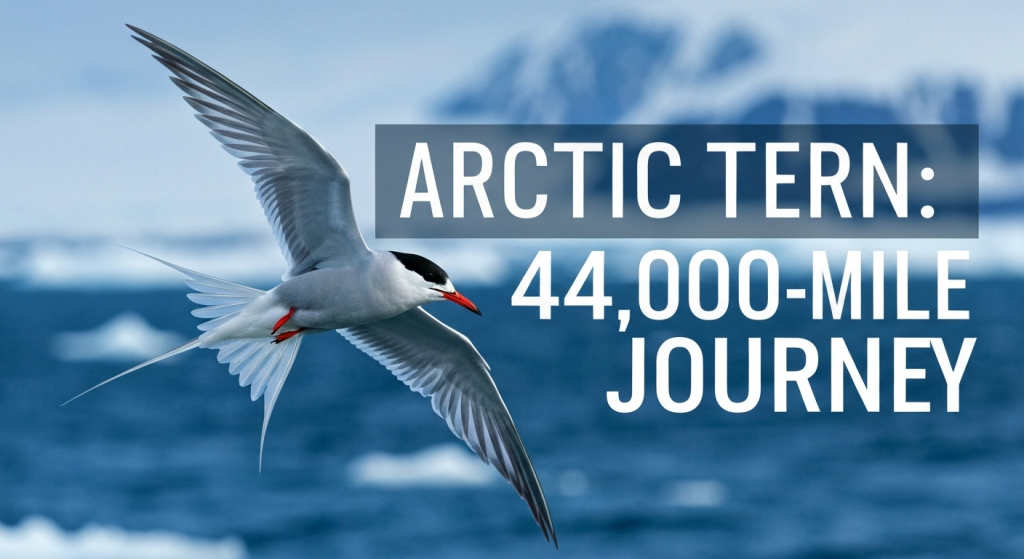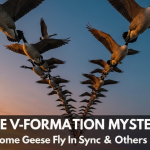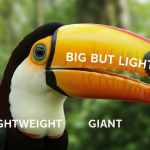The Arctic Tern’s migration is one of nature’s most staggering accomplishments. This small seabird, weighing barely more than a deck of cards, undertakes a journey that dwarfs any other in the animal kingdom. They fly from the top of the world to the bottom and back again every single year, a round trip of about 44,000 miles ( km). This isn’t just a flight; it’s a masterclass in navigation, endurance, and survival. They chase the summer, living in more daylight than any other creature on Earth. But how do they do it? How does this tiny traveler navigate a global-scale journey with such pinpoint accuracy, crossing vast, featureless oceans without a map or compass? The answer isn’t a single trick. It’s a sophisticated, built-in toolkit of senses that scientists are still working to fully understand. Let’s break down the incredible science behind how Arctic Terns navigate their epic pole-to-pole adventure.
For years, author Mahnoor Farooq has been exploring and writing about Bird Species, bringing research, cultural context, and clear explanations to readers. The sheer complexity of avian migration has been a long-standing fascination. After spending countless hours observing migration patterns and digging into the scientific literature, it’s clear that these journeys are far more than just instinct. They are a beautiful intersection of physics, biology, and an inherited wisdom passed down through generations. This article is born from that passion—a desire to translate the complex science of the Arctic Tern’s navigation into a story of resilience and wonder for everyone to appreciate.
More Than Just Instinct: The Tern’s Built-In Navigation Toolkit
When you first hear about the Arctic Tern’s journey, it’s easy to dismiss it as simple “instinct.” But that one word hides a world of complexity. Over my years of studying and writing about migratory birds, the most profound realization is that their navigation is a layered system. They don’t rely on a single sense; they cross-reference multiple sources of information to stay on course. It’s like a pilot using a GPS, a star chart, and wind speed indicators all at once. If one system is unavailable—say, clouds obscure the sun—another takes over. This redundancy is the secret to their success. They have an internal compass, a map, a clock, and a weather station, all working in perfect harmony.
The Global Positioning System of the Bird World: Magnetoreception
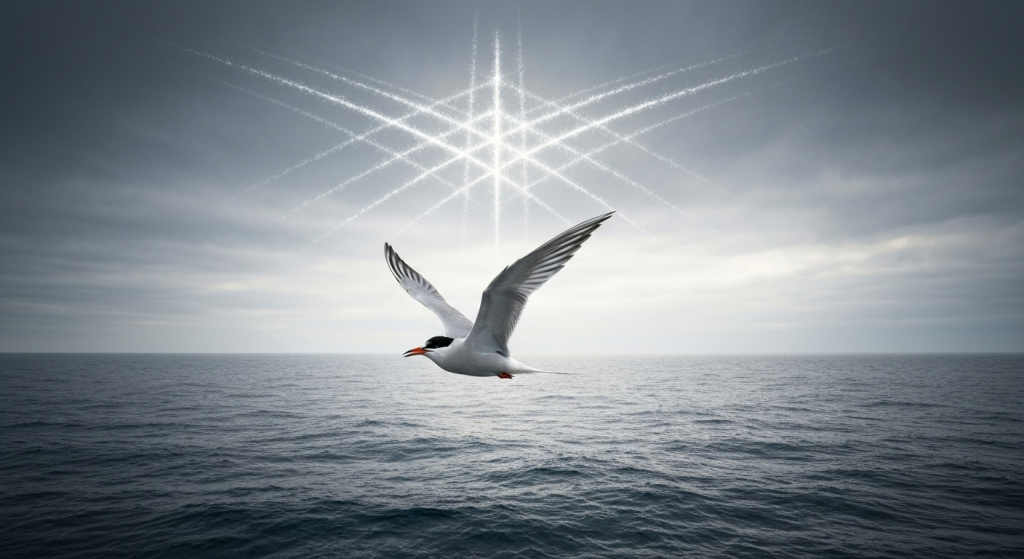
Perhaps the most fascinating tool in the tern’s toolkit is its ability to sense the Earth’s magnetic field. This sense, known as magnetoreception, functions like a biological GPS, providing both a compass for direction and a map for location. It’s a sense that is completely alien to us, but for the Arctic Tern, it’s fundamental to its survival.
How Terns “See” the Earth’s Magnetic Field
The leading theory behind this incredible sense sounds like something out of science fiction. It involves quantum physics happening right inside the bird’s eye. Here’s the breakdown:
- Cryptochromes: Terns have proteins called cryptochromes in their retinas. When these proteins are struck by light, they form a pair of molecules with electrons that are “quantumly entangled.”
- Entangled Electrons: These entangled electrons are highly sensitive to the direction of external magnetic fields. The Earth’s magnetic field influences how these electrons behave.
- A Visual Pattern: This influence changes the chemical reaction within the protein, creating a pattern of light and dark spots that is overlaid on the bird’s normal vision.
In simple terms, the Arctic Tern may actually see the magnetic field as a pattern in its field of view. This pattern changes depending on which way the bird is facing, giving it a constant, reliable compass heading, even in complete darkness or thick fog. It’s like having a heads-up display projected onto the world.
The Magnetic Map and Compass
The Earth’s magnetic field doesn’t just provide a direction; it also gives away location. The tern uses two key properties of the field to figure out where it is on its north-south journey.
- Inclination Angle: The magnetic field lines are parallel to the surface at the equator but point straight down at the poles. The angle of these lines (the inclination) tells the tern its latitude, or how far north or south it is.
- Field Strength: The intensity of the magnetic field is strongest at the poles and weakest at the equator. By sensing this strength, the tern gets another clue about its position.
This combination of a compass and a map makes magnetoreception an incredibly powerful tool for navigating the vast, empty expanses of the open ocean.
| Feature | Magnetic Compass | Magnetic Map |
| Function | Provides direction (North, South, East, West) | Provides location (specifically, latitude) |
| Mechanism | Senses the direction of the magnetic field lines | Senses the field’s strength and inclination angle |
| Analogy | A standard handheld compass | A GPS coordinate on a north-south axis |
Navigating by Starlight: The Tern’s Celestial Compass
Long before the science of magnetoreception was understood, observers knew that birds navigated by the sky. Arctic Terns use a celestial compass, relying on the sun during the day and the stars at night. This ancient method is still a core part of their navigational strategy, especially when fine-tuning their direction.
The Sun as a Daytime Guide
Using the sun to find your way seems simple, but it requires one crucial piece of equipment: an accurate clock. The sun’s position changes throughout the day. To use it as a compass, a tern must know what time it is. Luckily, they have a highly precise internal clock, or circadian rhythm.
By comparing the sun’s actual position in the sky with its expected position at that specific time of day, the tern can determine its direction with remarkable accuracy. This time-compensated sun compass is essential for the long daylight hours they experience during their journey. If clouds block the sun, they can even use patterns of polarized light in the sky, which are invisible to us but provide clues about the sun’s location.
The Night Sky’s Unwavering Beacons
For night travel, Arctic Terns switch to a star compass. While individual stars move across the sky, the patterns they form rotate around a fixed point. In the Northern Hemisphere, stars rotate around Polaris (the North Star). In the Southern Hemisphere, they rotate around a point near the Southern Cross constellation.
Young terns learn these rotational patterns before their first migration. By identifying the center of this rotation, they can find true north or south, regardless of the time of night. Classic studies, like the Emlen funnel experiments on other migratory birds, have conclusively shown that birds possess this innate ability to read the star map. This celestial guide is a reliable backup and a complement to their magnetic sense.
A Multi-Layered Backup System
The tern’s navigation is robust because it has multiple systems.
- For clear days: The sun compass is the primary tool.
- For clear nights: The star compass takes over.
- At dawn and dusk: Polarized light patterns offer guidance even when the sun is below the horizon.
- For cloudy conditions (day or night): The magnetic compass is always on, providing a foolproof sense of direction.
The Epic Journey Mapped: From the Arctic to the Antarctic
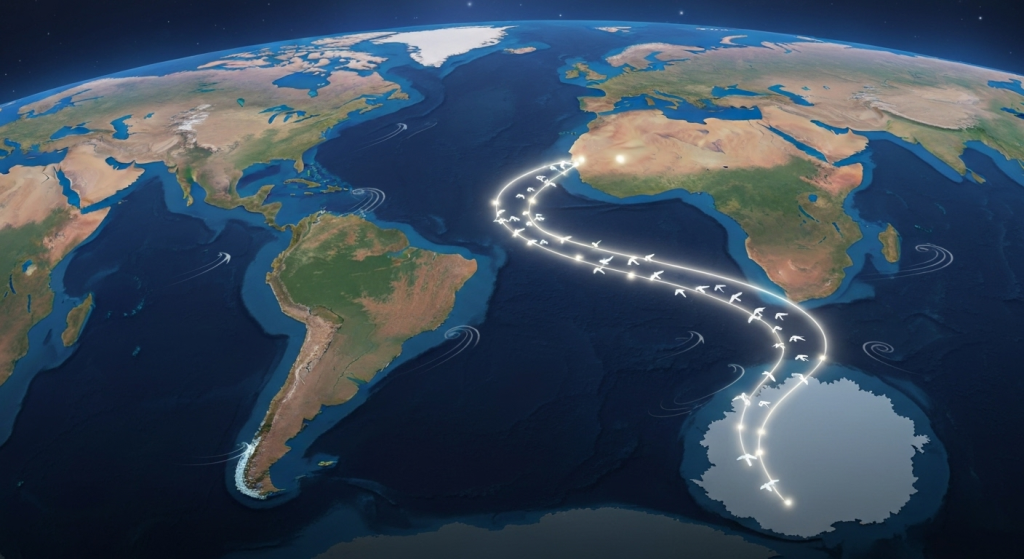
The Arctic Tern’s migration route is not a straight line. It’s a carefully chosen path that maximizes efficiency and follows food sources. This global highway reveals that their navigation is not just about finding a direction but about making smart, energy-saving decisions.
The S-Shaped Global Highway
Instead of flying directly south, most Arctic Terns follow a massive S-shaped pattern over the Atlantic Ocean.
- They leave their Arctic breeding grounds (like Greenland or Siberia) and fly south along the coasts of Europe and Africa.
- They then cut across the Atlantic towards South America.
- Finally, they travel down to the nutrient-rich waters of the Antarctic for the southern summer.
Why this winding path? Because it allows them to ride the prevailing global wind systems, like the powerful Westerlies and Trade Winds. From years of tracking these birds, it’s obvious they prefer the path of least resistance. Flying a longer distance with a tailwind is far more efficient than battling headwinds on a shorter, more direct route. This is a brilliant strategy that conserves precious energy for the marathon flight.
Strategic Pit Stops: Refueling for the Long Haul
The 44,000-mile journey isn’t flown non-stop. Arctic Terns make several crucial “pit stops” at strategic locations known as stopover sites. These aren’t random resting spots; they are specific areas with abundant food where the terns can rest and refuel.
One of the most important stopover areas is in the North Atlantic. Here, the terns feast on small fish and crustaceans, rapidly building up the fat reserves needed to power the next leg of their journey. The ability to navigate back to these exact, resource-rich locations year after year is just as impressive as their pole-to-pole navigation. It shows they have a detailed memory map of their entire route, not just a general sense of direction.
Master of the Winds: How Terns Exploit Weather Patterns
Beyond following major wind currents, Arctic Terns are masters of micro-navigation, constantly adjusting their flight based on local weather conditions. They are, in essence, avian meteorologists.
They can sense minute changes in air pressure, which helps them predict approaching storms and select favorable altitudes for flight. By flying higher or lower, they can often find a layer of air with a helpful tailwind. Over the ocean, they may also engage in a technique similar to dynamic soaring, used by larger seabirds like albatrosses. They use the difference in wind speed between the air just above the waves and the air higher up to gain lift and glide for long periods without flapping their wings. This constant, subtle exploitation of their environment is key to conserving energy over thousands of miles.
| Energy Saving Strategy | Description | Benefit |
| Following Wind Patterns | Choosing large, S-shaped routes to align with global wind currents. | Provides a powerful “push,” reducing the need for constant flapping. |
| Altitude Adjustment | Moving up or down in the air column to find the most favorable winds. | Maximizes speed and dramatically minimizes energy consumption. |
| Storm Avoidance | Sensing changes in barometric pressure to fly around bad weather systems. | Prevents being blown off course and ensures a safer journey. |
A Lifetime on the Wing: The Astounding Numbers
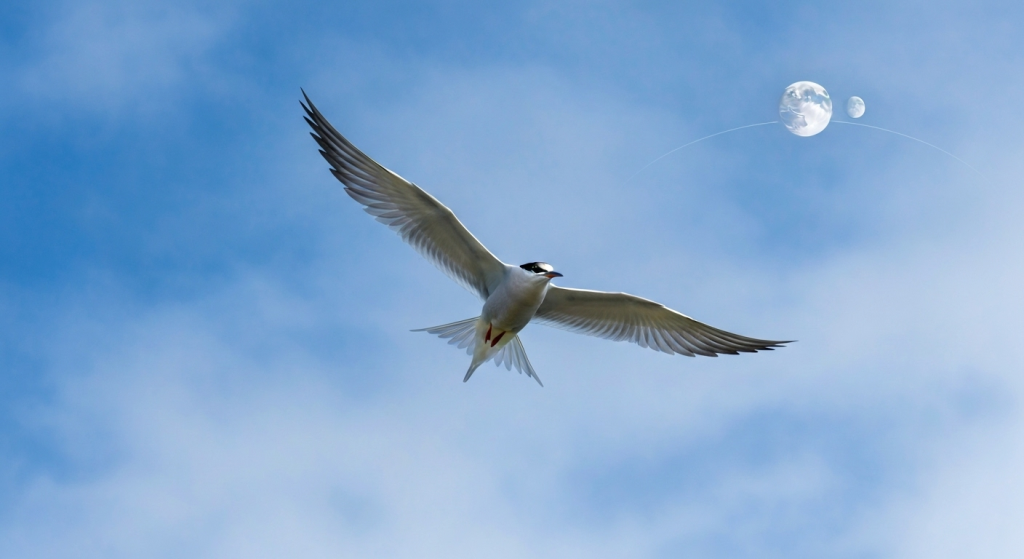
The statistics of the Arctic Tern’s life are almost unbelievable. With a lifespan that can exceed 30 years, a single tern will fly an astonishing distance.
- Annual Distance: ~44,000 miles
- Lifetime Distance: Up to 1.5 million miles (
million km)
To put that into perspective, 1.5 million miles is equivalent to flying to the Moon and back three times. Because they migrate from the Arctic summer to the Antarctic summer, they live in a state of perpetual daylight, experiencing more sun than any other animal on the planet. Theirs is a life spent on the wing, defined by an endless summer and an endless road.
Frequently Asked Questions (FAQs)
How do young Arctic Terns know where to go on their first migration?
It’s believed to be a mix of innate programming and social learning. A young tern is born with a genetic blueprint—an instinct to fly in a certain direction for a certain amount of time. They likely follow and learn from experienced adults in the flock during their first journey south.
Do Arctic Terns ever get lost?
Yes, it can happen. Severe, unexpected storms can blow birds far off course. However, their incredibly robust and layered navigation system often allows them to reorient themselves and get back on track once the weather clears.
How long does the migration take each way?
The one-way journey is not a quick dash. Including the crucial stops for refueling, a single leg of the migration from the Arctic to the Antarctic typically takes around 30 to 40 days.
Why do they fly so far?
It’s all about food and family. They fly to the Arctic for its 24-hour summer daylight and exploding populations of fish and insects, which is the perfect environment to raise their young. Then they fly to the Antarctic to take advantage of its summer, with its incredibly productive oceans, ensuring they have a rich food supply all year round.
Conclusion: The Unmatched Navigator
The Arctic Tern is more than just a bird; it’s a testament to the incredible power of evolution. Its annual journey, powered by a body weighing just a few ounces, is a feat of endurance that defies imagination. But it’s the beautiful complexity of its navigation system that is the true marvel. By combining a quantum compass in its eyes, a map of the Earth’s magnetic field, a clock set by the sun, and a deep, innate understanding of the stars and winds, the tern performs a navigational miracle twice a year. It’s a powerful reminder that some of the greatest wonders of our world are flying right over our heads.
